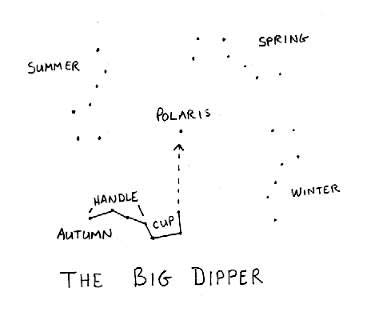But ask the same person to show you Ursa Major and Polaris in the night sky, and watch the confidence fade. Polaris? Is that the same as the North Star? Which way is north, anyway? Wasn't Ursa Major an actress from the sixties? What does she have to do with anything? And weren't we talking about the Big Dipper?
Don't be like that guy! Once you have learned to find the Big Dipper, it will point you to the North Star, the Little Dipper, and several other stars and constellations. You don't need a telescope, and the only fancy equipment you need is at the end of your hand.
The Big Dipper appears close enough to Polaris that, in much of North America, it never disappears below the horizon and is visible on any clear night. Below 40 north latitude (the northern edge of Kansas, Indianapolis, Philadelphia) the Dipper drops below the horizon for a few weeks in autumn. Depending on the time of year and the time of night, the dipper may appear to be right side up, upside down, or standing on end.

The first time you look for Polaris, the North Star, it will help you to have a general idea of which way is north. If you live in a city, find a location where the view to the north is free of obstructions (tall trees or buildings) and relatively dark. You may not be able to avoid some street lights, but if your patio overlooks a car dealership or a casino with zillion-watt lights all over the place, you should go somewhere else where you can actually see stars.
Four of the stars form a lopsided rectangle, or the cup of the dipper. The other three stars arc away from the top edge of the cup to form the dipper's handle. Actually, these seven stars are just part of a larger constellation called Ursa Major, or the Great Bear. For the purposes of finding north, though, the dipper portion is all you need.
Once you have found the dipper, locate the two stars that form the far edge of the cup, away from the handle. These are the pointer stars. Imagine a line starting at the bottom of the cup, running through the star at the top, and continuing on. Follow this line for about five and a half times the length of the distance between the two pointer stars, and it will lead you to Polaris.
If you are at a dark location, you will be able to see that Polaris marks the end of the handle of smaller dipper shape - Ursa Minor, or the Little Dipper. This constellation is dim, though, and can be difficult to see in urban locations.
Many people are surprised to see that Polaris is not especially bright. Its fame comes not from its brightness, but from its location almost directly over the North Pole. This fame is fleeting, though. Earth's axis wobbles slightly, and over a period of about 30,000 years, the North Pole will circle away from Polaris, toward stars as distant from it as Vega, before returning the present location.
This week's bonus view: On Monday, April 7, look for the moon to be very close to Saturn. Ove the next few days, the Moon will move westward toward, then pass by, Jupiter.

The Piker Press moderates all comments.
Click here for the commenting policy.